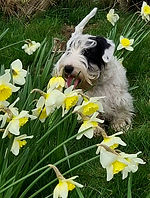
Midland Sealyham Terrier Club




Established 1923


.jpg)



About The Sealyham Terrier
The Sealyham Terrier also commonly known as “Sealys” are a rare Welsh breed of small to medium-sized dog which originated in Wales as a working dog. It is most commonly a white-bodied, rough coated breed with a double coat, a thick and soft undercoat and a tough, coarse outer coat. They were developed in the mid too late 19th century by Captain John Edwardes at Sealyham House, Pembrokeshire. Running through the grounds of the estate runs the Sealy river from which the estate takes it’s name. This quick flowing little stream, originating from the Precelli mountain range not many miles off. Sealy river ends its shortlife just outside the grounds of the estate where it flows into the Western Cleddau river.
Following the First World War, the breed surged in popularity and was associated with Hollywood stars and members of the British Royal Family. Over recent years the number of Sealyham Terriers have dropped significantly since the First World War resulting in the breed now listed as a Vulnerable Native Breed by the Kennel Club. In 2008 an all-time low was recorded where only 43 puppies were registered in the United Kingdom. Some have blamed the rapid decline of the Sealyham Terrier on a surge in foreign and designer breeds becoming more popular.
The Sealyham Terrier is equally suitable as a family dog or a working terrier as long as they are given the correct training. Sealyhams are mainly affected by two breed specific breed disorders with these being lens luxation and canine degenerative myelopathy.





The breed was first developed between 1850 and 1891 by Captain John Edwardes, at Sealyham House, near Wolfscastle in the Welsh county of Pembrokeshire. Originally the breed was used for pest control primarily to hunt small game and to eliminate vermin particularly badgers which he usually relocated.
There are a number of different breeds which have been cross bread to create the first Sealyham Terrier, The Welsh Corgi, Fox Terrier (Wire), and the now extinct English White Terrier all played a part in the make-up of the Sealyham Terrier,[1] however Edwardes did not keep detailed records of breeds which were used in the entirety which he used to create the Sealyham Terrier.
There were a number of different characteristics which Edwards wanted within his new breed. The main characteristics which he wanted was a small white dog with a strong jaw, and a wiry coat. The white coat was particularly prized by Edwards, a white coat would mean that the hunter in the field could distinguish the dogs from the quarry.
After Edwardes' death in 1891, other breeders began to work with Sealyhams, including Fred Lewis who promoted the breed. The breed was shown for the first time in 1903, and the Sealyham Terrier club was created in 1908. The breed was finally officially recognised by the Kennel Club in 1911.[3] Now the Sealyham Terrier is recognised by all of the major kennel clubs in the English-speaking world. During the early stages of its recognition by the Kennel Club the Sealyham Terrier was also known as the Welsh Border Terrier, or the Cowley Terrier.
During the 1920s and 1930s, Sir Jocelyn Lucas used the dogs to hunt a variety of different creatures such as badgers, otters, stoats and squirrels which he usually relocated where possible. Sir Jocelyn Lucas decided that he did not like the Sealyham as a hunting dog as they were in his eyes bread for the conformity of the show ring and wanted something else. He crossed the Sealyham Terrier with the Norfolk Terrier to create a new breed called the Lucas Terrier which he described as “death to rats and rabbits".
In the 1920’s the Sealyham Terrier was once one of the most popular terriers with over 2,000 puppies registered in the UK as well as being one of the best known Welsh breeds. This is a stark contrast to 2008 where puppy registrations with the Kennel Club UK dropped to an all-time low with only 43 puppies registered with the Kennel Club UK putting the breed into the bottom three breeds of the Vulnerable Native Breeds. In October 2011, British magazine Country Life highlighted the Sealyham on its front cover, with the heading "SOS: Save our Sealyhams" and launched a campaign to save the breed. Even with the support of Country Life at the end of 2011 there were only 49 puppies registered with the Kennel Club UK keeping the breed within the bottom three on the list of most endangered breeds.
Another notable Sealyham Terrier, Ch. Efbe's Hidalgo At Goodspice, also known as Charmin, won Best In Show at Crufts in 2009, but his victory was not televised as the BBC had dropped the coverage of the competition earlier that year, following the controversy after the channel showed the documentary Pedigree Dogs Exposed. He had previous won the AKC/Eukanuba National Championship in the United States in 2007, and the World Dog Show in 2008.